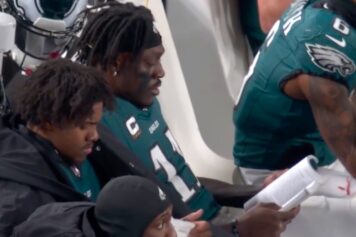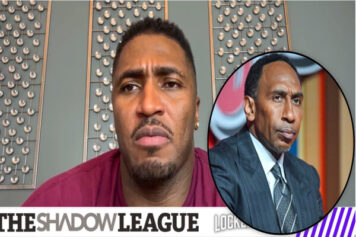Bud Adams isn’t as reviled in Houston as Art Modell is in Cleveland, but it’s pretty damn close.
After announcing his plans to relocate the Houston Oilers on November 16, 1995, the mercurial owner talked his way out of his lease at the Astrodome a year early to move the team to Tennessee. Over in Nashville, Mayor Phil Bredesen promised to build his team a spankin’ new $200 million 65,000-seat stadium.
Cleveland has long been billed as the longest, long-suffering sports town – ridiculed for both its postseason heartbreak, and lack of championships in the professional ranks. But when Modell wanted to take his ball and go to Baltimore for the want of a bigger and better stadium, Browns’ fans saw past their hatred of the team owner and fought tooth and nail to keep the team in Cuyahoga County. To Cleveland fans, the Browns were more than just an NFL team, the Browns represented Cleveland, they were part of the Cleveland lifeline. The Browns were Cleveland and there was no way in hell they’d let them leave without a fight, ya dig?
But Oilers fans? Not so much.
The Houston Texans are balling. It may not be a consensus, but the bulk of observant NFL fans consider the Texans to be the best, most balanced squad in the league. The city loves the Texans. But, now that things are the way they are, it might be hard for the unknowing to imagine that there was a time when H-Town, as a whole, didn’t give a damn about its pro football team. After Houston lost its last home game at the Astrodome 21-13 to the Cincinnati Bengals in 1996, it was Judgement Day. That was the day the Oilers lost all of its foam-fingered and face-painted disciples. Those same diehards that once bled Columbia blue left puffed up with hate for Adams and full of apathy towards a team that had missed the playoffs for three straight seasons. It was at that moment that the fans all but gave the team a Timberland boot out of town. You want to take the team to Nashville? Go ahead, Bud. We don’t care. Take ‘em. Leave. Matter of fact, leave now. Get your gang of losers and get the “blank” out of town.
Ironically, by ditching the only NFL franchise they’d ever known, Oilers’ fans were being just as disloyal as the owner they despised. After 36 years, pro football in Houston went the way of three dozen candles blown out on a birthday cake. Poof. Gone. History.
*********************
The Oilers set up shop in Houston in 1960 as part of the American Football League after Adams, who made his millions as a real life J.R. Ewing, was unsuccessful in his bid in bringing an NFL expansion team to the city. In the AFL, the Oilers reigned supreme, winning two AFL championships before the AFL-NFL merger in 1970 made Houston an official team in the AFC Central Division. The Oilers built their following slowly until 1975, when the franchise made a move that changed the course of the franchise forever. That year, the Oilers hired Bum Phillips, a potbellied country boy who wore ten-gallon hats and ostrich boots. Dude was more redneck than NFL head coach. Phillips ushered in an era of that freewheeling, Texas-western grit and Oilers fans took to him and his coaching style like fish to water. Pacing the sidelines with a mouth full of chewing tobacco, spitting at will without a spittoon, the rotund general talked more sh!t than the loud mouth, know-it-all cat at your barbershop (the one that never gets a cut, but he’s always there) and became one of the most memorable characters in NFL history.
For five years, Phillips energized the city, reversing the fortunes of the franchise with his “team as family” mantra. But it was the ’78 and ’79 squads that captivated Space City. It was the game against the Miami Dolphins on Monday Night Football. You remember Earl Campbell, right? He was the first Jim Brown after Jim Brown – a one man wrecking crew. Fans loved him because he fit into that ol’ “everything is BIG in Texas” mold and he didn’t back down. Ever. And the brotha ran through defenses like they were wet plies of cheap toilet paper. You didn’t want it with Big Earl. That Monday night, Campbell beasted his way through Dolphins defenders for 199 rushing yards, helping propel the team to a 35-30 victory. It was a seminal moment for the Oilers as a national entity and Houston’s object of affection.
In a tribute to the team, the “Luv Ya Blue” anthem was penned to honor the players and started an entire movement in the city.
If the Dallas Cowboys are thought of as America’s Team, just imagine the monopoly they can have on Texas fans. But, there were two different times when it was thought that the Oilers broke out of that Dallas-star’s shadow. The first was during the Bum Phillips era. The second was when Warren Moon was doing his thing.
Moon ushered in the run-and-shoot offense—16 reads for every snap of the ball. He was prolific. He was aerial mastery. He was Thelonious Monk with the spiral, improvisation from the pocket. The Oilers made NFL history in 1990 when they had four receivers each catch 65 or more passes in one season. Four. Moon wasn’t just a black QB, he was a QB’s QB. He brought Ws – seven straight playoff appearances. He gave back. He built churches. Moon led Houston to the AFC Central division crown with a 12-4 record, its best record in franchise history. But, as with the previous six postseason’s, the Oilers failed to advance to even the AFC Championship game, let alone a Super Bowl. Moon, in his late-30s, was entering the last two years of his contract and would have earned $3.25 million the next season. Cody Carlson, the Oilers' backup, was scheduled to earn $3 million this season. The Oilers, according to reports, felt they couldn’t devote $6.5 million of a $34.608 million salary cap to two quarterbacks. So, Adams let MOON go, trading him to Minnesota (where he threw for 4,200 yards the next two seasons. What did Houston get? A fourth-round pick in the 1994 draft and a conditional third round pick in 1995. Houston fell apart. They went 2-14 the following season, sinking into the lean years and the Oilers of lore were nothing but a distant memory.
When Bud Adams moved the team to Nashville, he got everything he wanted: $28 million in relocation costs, a $35 million contingency fund for miscellaneous items and payment to the NFL, and $29 million in land acquisition and site improvement. In total, the package was worth approximately $292 million.
But Houston? All they got was a stunning reality check and seven years in pro football purgatory.
Fans, so quick to jettison Adams and the Oilers out of town, were despondent – going through pigskin withdrawal. No football? No team? In a state where football was almost a religion, to have no team to cheer on any given Sunday was sacrilege. Fans questioned why they ever let their team get away in the first place. While Houston caught the vapors—word to Biz Markie—the Oilers became the Titans and the Titans were going to Super Bowls. It was an empty time. Fans hungry to root for a team started reaching back to their Louisiana roots and joined up with the New Orleans Saints. Worse, some even committed treason and starting supporting the Dallas Cowboys. Nah, that can’t be life. The city and the fans, hell-bent on the NFL’s return to Houston, set out on a mission to get football back.
*********************
And to think, the biggest breakthrough came from some rodeo clowns.
Initially, when Adams pushed for a new stadium, he was trying to part ways with the Astros and the Houston Livestock Show and Rodeo. Rodeo officials didn’t back Bud, but threw their support behind a new baseball park with one explicit demand: they wanted the city to build a new football stadium for rodeo use.
Houston acquiesced to the Rodeo’s demands, hoping that it would help in enticing the coterie of NFL owners to give the city another NFL franchise. Voters approved the new football stadium in 1996 and Houston was granted an expansion NFL team. The $450 million stadium was paid for with money from the team, local taxes on hotels and rental cars and, of course, the rodeo.
Hollywood couldn’t have written a better opening game script for the Texans in their new digs. Matched up against their instate rival Dallas, Houston managed an improbable upset victory over the ‘Boys in front of a packed house that included all of the famous former Oilers: Warren Moon, Sean Jones, Gregg Bingham, Allen Pinkett, Al Smith, Ray Childress and Dan Pastorini, the QB that marshaled the Oilers in their heyday and even dated Farrah Fawcett. Even President Bush was in the house.
For that game, it was a role reversal of fortunes: the expansion team looked like the perennial powerhouse and the storied franchise looked like neophytes among pros. For that moment, the first step in a long journey back to NFL prominence, the Houston Texans were on top of the sports world and its owner, Bob McNair, the man who brought football back to life, absorbed the praise showered upon him by grateful fans for one of the most memorable nights in Houston sports history.
This season, the Texans are off to the best start in franchise history with five straight victories and no losses. With perhaps the most complete team they’ve ever had, Houston is poised to win the AFC South for the second straight year and is a real championship contender. You can’t tell a Texans fan that the team isn’t going to the Super Bowl. Andre Johnson? Matt Schaub? Arian Foster? Arian freckin’Foster?! Hands down the best back in the L. They sell out every home game. People are wearing Texans gear to work. Women are painting their nails in Texans colors. Even the Benedict Arnolds that bolted for the Saints and the Cowboys came back into the fold. “Luv Ya Blue” may no longer rain down from the mezzanine to the astroturf, but the Texans newest rallying cry, "Bulls On Parade," can be heard shaking and rattling Reliant Stadium, propelling the Wade Phillips driven defense—fans can’t believe how lucky they are to have JJ Watt—to new heights and spark-plugging the offense to end zone glory and, more importantly, collective redemption.
Oilers? No. Houstonians are Texans now.



